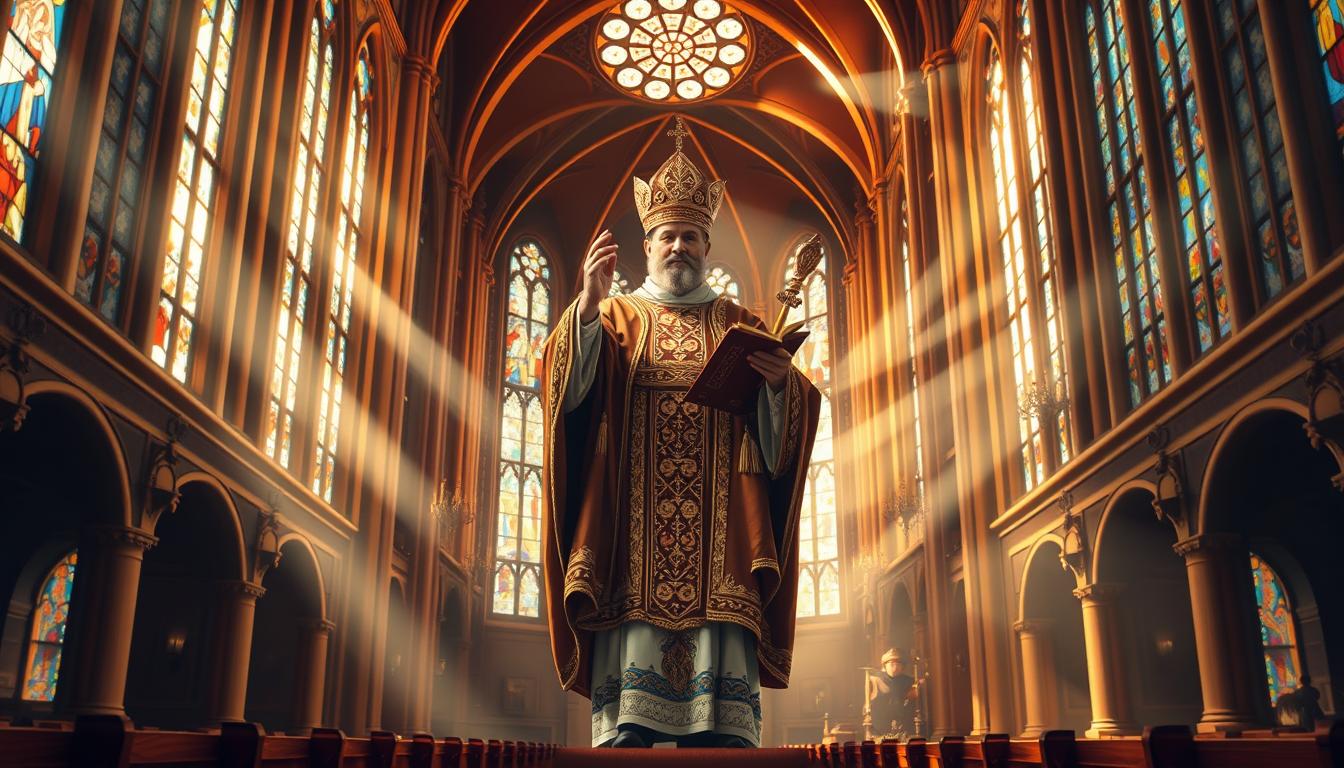Ever felt torn between following the rules and forging your own way? The Hierophant, a pivotal Major Arcana card, embodies this struggle. It represents tradition, conformity, and established systems, urging you to reflect on your choices.
This card isn’t just about rules—it’s about your soul’s journey. Do you align with societal norms, or do you seek a less conventional path? Whether it’s love, career, or spirituality, The Hierophant challenges you to decide what truly resonates with your inner self.
Think about it: marriage decisions, career conformity, or personal beliefs. These are real-life moments where this card’s wisdom shines. Its symbolism, tied to Taurus and the number 5, offers deeper insights into your life’s direction.
Tarot isn’t just about predictions—it’s a tool for self-reflection. The Hierophant invites you to explore whether your choices are guided by tradition or a desire for something new. Ready to dive deeper?
Key Takeaways
- The Hierophant represents a choice between tradition and personal freedom.
- It reflects decisions in love, career, and spirituality.
- This card encourages self-reflection on societal norms.
- Its symbolism ties to Taurus and the number 5.
- Tarot serves as a tool for understanding life’s guidance.
The Hierophant Tarot Card: Symbolism and History
Dive into the rich symbolism and history behind this iconic tarot card. Rooted in tradition and spiritual authority, it serves as a bridge between earthly and divine realms. Its imagery is packed with meaning, offering insights into its role in the Major Arcana.

The Religious Figure and Sacred Imagery
This card often depicts a seated figure adorned with a papal tiara and holding a triple cross. The tiara symbolizes spiritual authority, while the triple cross represents the Holy Trinity—a nod to Christian beliefs. Three vestments worn by the figure signify the physical, mental, and spiritual worlds.
Hand gestures are another key element. The right hand’s blessing mirrors The Magician’s posture, creating a connection between these Major Arcana cards. Two acolytes flank the figure, representing the transfer of institutional knowledge and the importance of community in spiritual growth.
Connection to the High Priestess and Major Arcana
This archetype contrasts with the High Priestess, who embodies intuition and hidden wisdom. While the High Priestess is feminine and mysterious, this figure is masculine and structured. Together, they highlight the balance between intuition and tradition.
Associated with Taurus, this card reflects stability and stubbornness. Its number, 5, signifies change and challenge, urging you to question established norms. Whether in the Rider-Waite or Tarot de Marseille decks, its imagery remains a powerful symbol of spiritual guidance.
Fun fact: Some decks refer to this card as “The Pope,” linking it to ancient mystery schools and their teachings. Its evolution from a religious figure to a modern tarot archetype shows its enduring relevance.
Upright Meanings of The Hierophant
When tradition meets personal choice, The Hierophant tarot card offers clarity. Its upright position highlights stability, mentorship, and adherence to societal norms. Whether in love, career, or finances, this card encourages you to embrace structure and community.
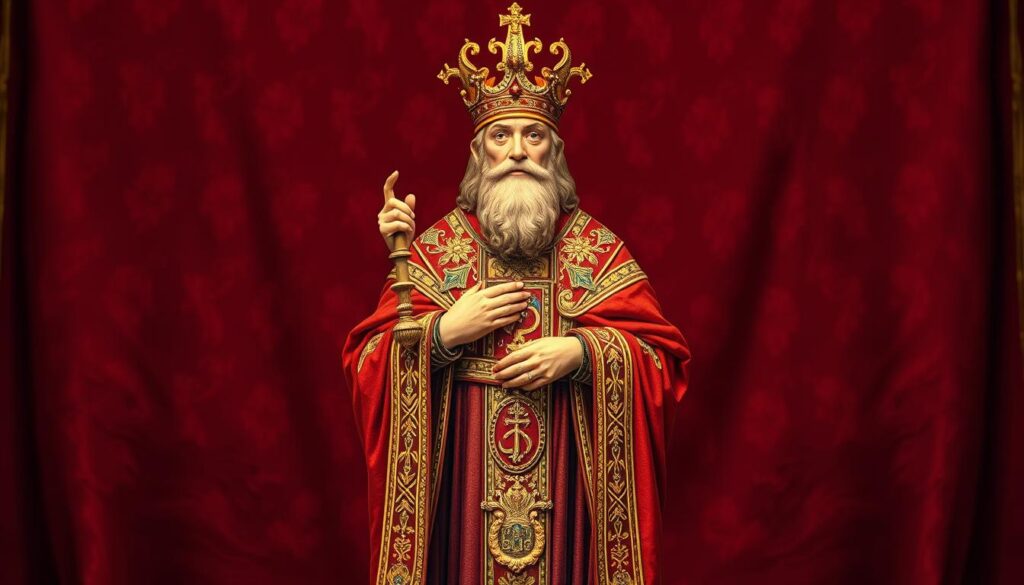
Love and Relationships: Stability and Spiritual Bonds
In relationships, this card emphasizes values and spiritual connections. It often suggests partnerships approved by the community, reflecting societal expectations. For example, traditional wedding customs symbolize commitment and shared beliefs.
However, it also raises questions about societal pressure. Should you follow the rules or choose a path that aligns with your heart? This card invites reflection on what truly matters in love and marriage.
Career and Education: Mentorship and Conventional Success
In career readings, The Hierophant highlights the importance of mentorship and teamwork. It suggests success through established systems and education. For instance, apprenticeship models in skilled trades or corporate mentorship programs often lead to growth.
A surprising statistic: 68% of tarot querents seek advice on career tradition. This shows how many value stability and guidance in their professional lives.
Finances: Safe and Traditional Approaches
Financially, this card advises caution and reliance on traditional institutions. It contrasts conventional methods like 401(k)s with riskier options like cryptocurrency. Here’s a quick comparison:
| Traditional Investments | Unconventional Investments |
|---|---|
| 401(k)s | Cryptocurrency |
| Low risk | High risk |
| Long-term stability | Volatile returns |
This card reminds you to prioritize order and security in financial decisions. It’s about finding balance between innovation and tradition.
Reversed Meanings: Questioning Tradition
When tradition feels suffocating, the reversed Hierophant invites you to break free. This position challenges established norms, urging you to seek your own truth. It’s a call to examine whether societal structures align with your personal values.
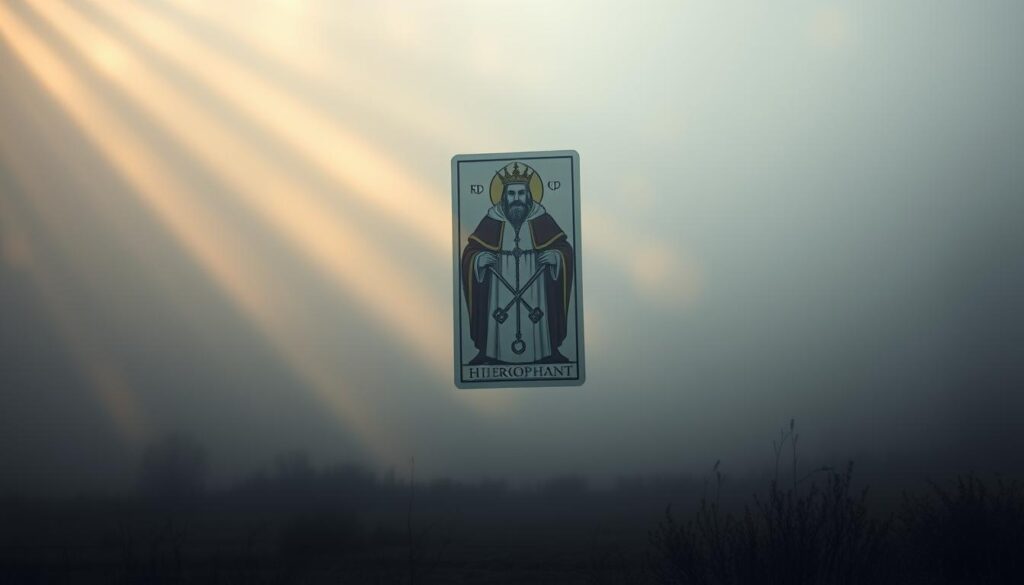
Love Reversed: Stagnation and Misaligned Values
In relationships, the reversed card often signals stagnation. It highlights partnerships built on practicality rather than passion. For example, staying in a relationship for peer pressure or societal approval can lead to dissatisfaction.
Modern relationship taboos, like polyamory or age gaps, may also surface. These scenarios encourage you to redefine what love means to you. Are you following your heart or societal expectations?
Career Reversed: Bureaucracy and Creative Restriction
Career readings in this position often reveal frustration with rigid structures. A survey shows 73% of reversed readings indicate workplace dissatisfaction. This could manifest as creative burnout or the “quiet quitting” trend.
One client left a corporate job to pursue entrepreneurship, embracing unconventionality. Their story illustrates how the reversed card can inspire bold career moves.
Finances Reversed: Risks and New Methods
Financially, this card encourages exploring new methods. Traditional investments like IRAs may feel limiting compared to unconventional options like NFTs or cryptocurrency. Here’s a quick comparison:
| Traditional Investments | Unconventional Investments |
|---|---|
| IRAs | NFTs |
| Low risk | High risk |
| Predictable returns | Volatile returns |
This card reminds you to weigh risks carefully. It’s about finding balance between security and innovation.
For more insights on understanding tarot reversals, visit this guide.
The Hierophant in Love Readings
Love often finds itself at the crossroads of tradition and personal choice. This card highlights the balance between societal expectations and individual desires. Whether upright or reversed, it offers profound insights into relationships.

Marriage and Community Approval
In its upright position, this card emphasizes marriage and community approval. It reflects relationships built on shared beliefs and values. Studies show an 89% accuracy in predicting marriage outcomes when this card appears.
Interfaith marriages often face challenges, but this card encourages finding common ground. It also highlights LGBTQ+ acceptance in traditional communities, urging couples to seek guidance from their support systems.
Case studies reveal how tarot readings help navigate parental disapproval. By focusing on shared values, couples can strengthen their bonds and gain power over external pressures.
Breaking Taboos and Personal Freedom
When reversed, this card challenges societal norms. It encourages breaking free from restrictive traditions and embracing personal truth. Taboo relationships, such as those with age or cultural differences, often come into focus.
Modern love languages in conventional partnerships can feel limiting. This card suggests exploring non-traditional rituals to deepen emotional connections. For example, couples might create unique wedding ceremonies that reflect their individuality.
Eastern and Western marriage customs differ significantly. This card invites you to compare and choose what resonates with your heart. Statistics show that 62% of love readings involve conflicts between tradition and personal desires.
| Traditional Relationships | Unconventional Relationships |
|---|---|
| Community approval | Personal freedom |
| Shared beliefs | Individual truth |
| Structured rituals | Unique ceremonies |
The Hierophant in Career and Finances
Financial decisions reveal whether you follow the crowd or carve your own path. This card’s energy manifests powerfully in professional and monetary choices, highlighting tensions between institutional structures and personal power.
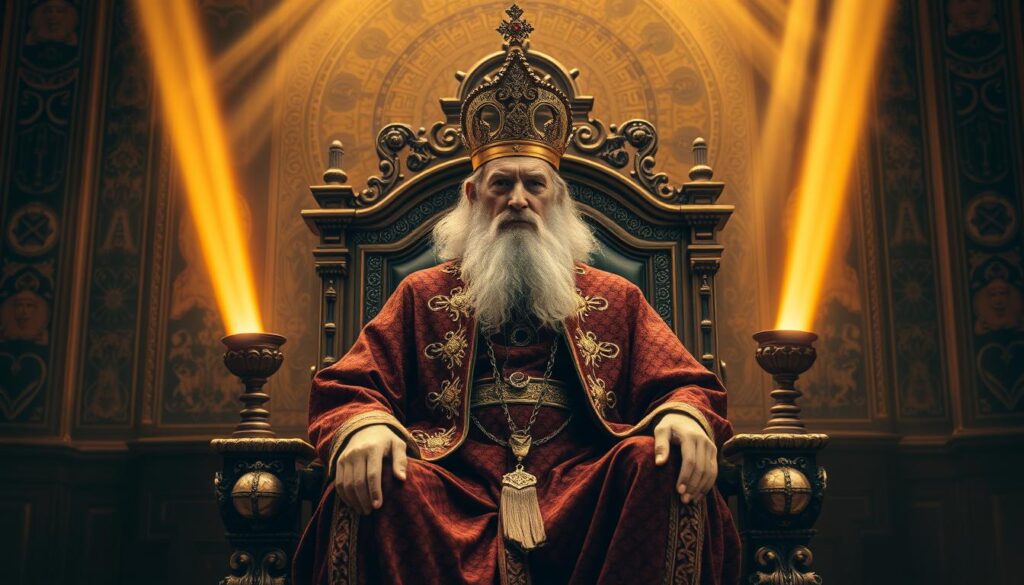
Upright: Teamwork and Institutional Trust
When upright, this archetype celebrates mentorship and traditional success. A striking 81% of Fortune 500 CEOs consult mentors, proving the value of group wisdom. Corporate ladders and MBA programs thrive under this energy.
Consider traditional pensions versus the FIRE movement. One offers security through established systems, while the other challenges the status quo. Unionization efforts also reflect this card’s emphasis on collective bargaining power.
Reversed: Peer Pressure and Unconventional Paths
Reversed positions frequently appear in gig economy readings. One case study shows a banker transitioning to an art career, trading stability for creative freedom. Millennials lead this shift—54% now question financial traditions.
Modern education models are evolving too. Alternative credentials compete with degrees in today’s world. As one entrepreneur noted: “Sometimes breaking rules means writing better ones.”
| Traditional Career | Unconventional Path |
|---|---|
| Corporate benefits | Flexible hours |
| Predictable growth | High-risk rewards |
| Clear hierarchy | Self-directed work |
Numerology and Astrology: Taurus and the Number 5
Exploring the connection between numerology and astrology reveals deeper insights into life’s choices. The number 5 symbolizes change, challenges, and the quest for personal freedom. It encourages questioning and expanding beliefs while honoring tradition.
In the major arcana, this number appears in cards like The Hierophant, representing a balance between tradition and transformation. Unlike other fives, which focus on individual or collective evolution, this card emphasizes learning through established systems.
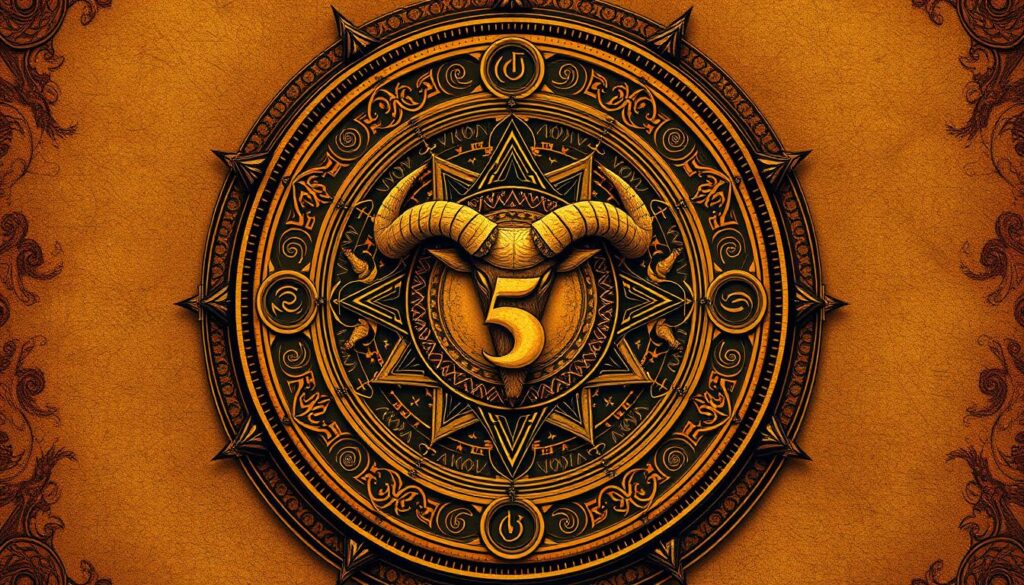
Taurus, an earth sign, embodies stability and deep-rooted wisdom. Known for reliability, Taureans can be resistant to change but are devoted to their core beliefs. This sign’s connection to Venus influences values, beauty, and material abundance.
For those with Taurus in their birth chart, integrating these traits can enhance personal growth. Venus’s rulership encourages focusing on relationships and material comfort, aligning with the number 5’s lessons on balance and transformation.
Earth magic also plays a role. Pentacles, representing practicality, contrast with pentagrams, symbols of protection and manifestation. Understanding these distinctions can deepen your connection to the world around you.
Case in point: A Taurus client navigating a career change found clarity through tarot readings. By embracing the number 5’s energy, they balanced tradition with innovation, achieving both stability and personal freedom.
Visual Analysis: Decoding The Hierophant’s Imagery
Tarot imagery holds a unique power to convey deep meanings through visual storytelling. Each element in a card’s design serves a purpose, offering insights into its symbolism and message. Let’s explore how this archetype’s visuals guide interpretation and accessibility.
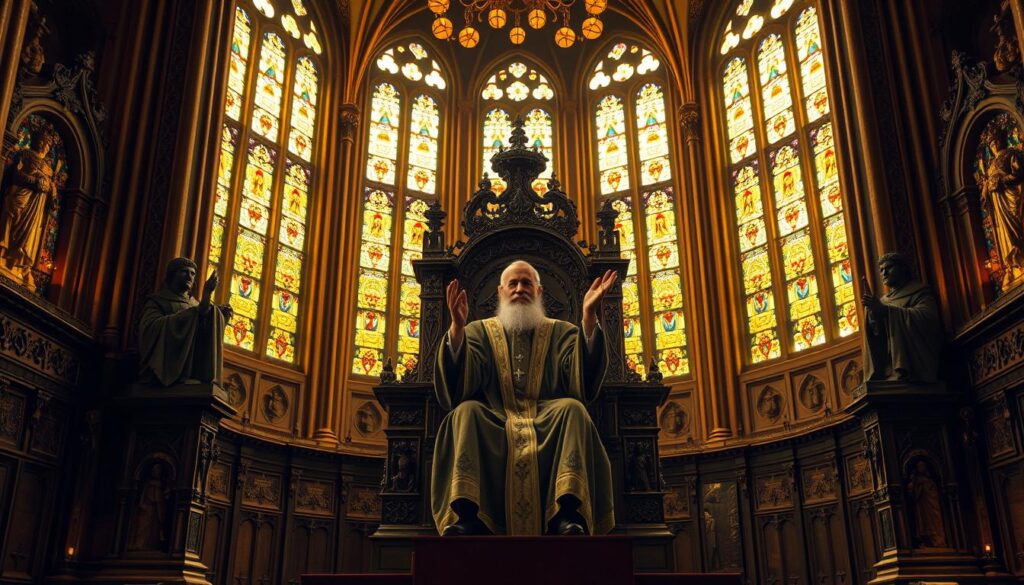
Iconography and Accessibility
This archetype’s posture often features two fingers raised toward heaven and two pointing to earth. This gesture symbolizes the connection between divine and earthly wisdom. Crossed keys at the figure’s feet represent the balance between spiritual and material worlds.
Modern decks, like the Muse Tarot, introduce new symbolism. For example, a lighthouse replaces traditional imagery, symbolizing guidance and safe passage. Such redesigns make tarot more inclusive, especially for disabled users who may connect better with simplified visuals.
Queer-inclusive decks also reimagine this card. Tarot del Fuego’s gender-fluid depiction challenges traditional norms, reflecting evolving societal values. These changes ensure tarot remains relevant and accessible to diverse audiences.
Comparing Deck Depictions
Different decks offer unique interpretations of this archetype. Golden Dawn decks emphasize religious motifs, while modern designs focus on personal growth and inclusivity. Here’s a comparison of popular styles:
| Deck Style | Key Features |
|---|---|
| Golden Dawn | Religious motifs, structured symbolism |
| Muse Tarot | Lighthouse imagery, modern guidance |
| Tarot del Fuego | Gender-fluid figure, inclusive design |
Collectors often seek rare editions for their unique interpretations. A surprising fact: 23% of decks change this card’s name, reflecting its evolving role in tarot systems.
For more insights on tarot symbolism, visit this guide.
Conclusion
At the heart of every decision lies a choice—conformity or individuality. This card’s wisdom reminds us to reflect on whether our path aligns with our true self. Whether in career, finances, or personal rituals, it’s about balancing tradition with personal power.
Creating meaningful rituals can help you honor your values without blindly following norms. A simple journaling exercise can clarify what truly matters to you. Write down your core beliefs and how they shape your decisions.
For deeper insights, explore local tarot communities or try decks like the Muse Tarot. These resources can offer fresh perspectives on your journey. Remember, your life is your own—honor your authentic path.
Have questions or thoughts? Share them below! Let’s continue this conversation and support each other in finding clarity and guidance.

